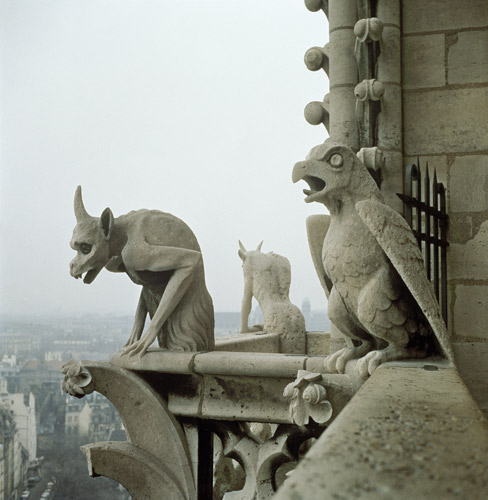The world was stunned to see fire consume the iconic Notre Dame Cathedral, punctuated by it's 300 foot spire, falling like a sequoia wrapped in flame. No matter how you feel about it, it's an event we will not soon forget. That spire was just one of many features that made the cathedral an historic and architectural wonder. Truth be told, the spire was not original to the structure, but reimagined in the 19th century to replace another as part of a restoration by 30 year old French architect and gothic revivalist, Eugene Voillet-Le-Duc.
An interesting character indeed.
Eugene Auguste Voillet-Le-Duc
1840’s construction of the spire addition.
His name came to mind in the early 90's when I was living in Paris as a Disney Imagineer, involved in directing the design of what would soon become Disneyland Paris. The city fascinated me (as it does all of us) and at times I wondered who was the "Walt Disney" of french culture? Hugo, Hausmann, Moebius? Touring the many restored monuments, castles and cathedrals, you'd eventually learn that many of the interiors were actually reimagined and enhanced (versus restored) in the late 1800's by the same Eugene Viollet-Le-Duc. He was a romantic that wanted to deliver the heroic medieval designs that only could be imagined, going well beyond restoring what was there. In fact, he changed it. He seemed to embrace the reason the building existed as his directive and the story that inspired it . Kind of like what a theme park is to historic reality, only he was remaking real places! He imagined his castles filled with knights in shining armor, versus their stone cold reality. Very Disney. Very experiential.
Character Design
The sinister Gargoyles added by Voillet-Le-Duc have become souvenirs to many. Very theme park.
Like any good storytelling environment, you need colorful characters. Like Disney, Voillet-Le-Duc added his own, the signature Chimera and Gargoyles to lend a sense of medieval fantasy. Ironically, they eventually became animated Disney characters in “The Hunchback of Notre Dame”!
In a bold move of personal branding and despite a scriptural mandate against idolatry (2 Cor 6:16), Eugene adds his own likeness to the spire, joining the apostles as St. Thomas, the patron saint of architects! It makes sense, as he wasn't religious, nor a catholic, but a patriot that wanted to romanticize French history as a thematic inspiration. I think that's one reason so many see the cathedral as central to the identity of France beyond any religious significance.
Voillet-Le-Duc (as St. Thomas) looks up at his tower while the other Apostles look back at the city.
“Superfranco-heroistic-expalidocious!”
After Notre Dame, he tacked many more assignments across France. I visited his last project before he died, the nearby Castle of Pierrefonds, restored for Napoleon III. The once crumbling and scarred ruins were transformed with color, pageantry and regal splendor. A personal favorite. He brought the fairytale emotion and romanticism to the events that made French culture, decorating the walls with shields and patterns, polychrome capitals and sculpture, fleur-de-lis and crests. He did similar at Saint Denis, Amiens, Vincennes and more. As Walt Disney took fairy tales or secular history and romanticized them in his theme parks, Eugene brought "story" to these places and used architecture to bring emotion to the lifeless ruins and monuments. Today most just accept what they see as the way things really were, but like the spire mourn their loss as they made an emotional impression.
Chateau Pierrefonds interior as reimagined in regal splendor. Stunning and you should see it.
Pierrefonds intricate use of pattern, color and detail bring history to life..
Twice upon a Dream
To make the connection between the two an even closer "six degrees of ornamentation," The Sleeping Beauty Castle at Disneyland lends it's own tiny nod to the French master with a faux gilded version of the famous spire.
As they say, if you’re gonna borrow…..borrow from the best!
“Six Degrees of Ornamentation”- The famous spire lives on Sleeping Beauty’s Castle at Disneyland.
Point being, some of the places we are moved by are conceived and designed with an emotion in mind. Eugene Voillet-Le-Duc and Walt Disney were both visionary romantics and used their skills to inspire. That's experiential design at it's best.







